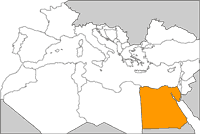 |
National Parks
- Elba
- Ras Mohammed
- Tiran and Sanafir Islands
Natural Areas
- Alaba mountains
- Bardawil Lake
- El Dakhla Oasis
- El Maadi petrified forest
- Gebel El Khaseb Petrified Forest
- Hamata Marine Zone
- Hettiat El Mogharrah Oasis
- Shayeb-el-Banat Mountains
- St Katherine
- Wadi el Alaqi
- Wadi Habib
- Zaranikh (El Arish)
Nature Reserves
- Ashtum El Gamil
- El Farafra Oasis
- El Kharga Oasis
- El Mallaha Lake
- Hurghada
- Lake Manzala
- Oweinat Mountains
- Qarun Lake (Quaron)
Marine Parks
- Bay of Abu Qir
- Giftun islands
- Nile Estuary (Rosetta)
- Ras Garra
- Southern Egypt
Marine Reserves
- Gubal Islands
- Qulan Islands
- Ras Abou Hagar
Protected Coastline
- Dahab
- Sharm-el Sheikh
- Taba Coast
Natural Monuments
Bird Sanctuaries
- El Tina
- Sbekha
- Serbal Mountains
|
Protected Areas in Egypt
A detailed understanding of the environment has existed over many millennia as seen on ancient temple inscriptions such as that of Queen Hatsephut of the ancient pharaoh period (1540 BC). Traditional forms of protection still exist; a number of areas were regarded as sacred under the traditional law of the local bedouin tribes, such as at Mount Sinai where permanent hunting bans were enforced by the local populace. At Gebel Elba the nomadic communities maintain restraints, through tribal and religious dictates, on the over exploitation of natural resources.
The first conservation legislation this century came into being with the creation of the Royal hunting reserve at Wadi Rishrash in 1900.
The EEAA, Egyptian Environmental Affairs Agency, is today the main administrative body responsible for the enforcement of environmental protection and conservation, and was established under Decree No. 631 of 1982. In 1979, the Egyptian Wildlife Service (EWS) was established under the authority of the Ministry of Agriculture, with responsibility for management of natural protectorates and wildlife research.
Each protected area has a board which is responsible for managing the site. The members of the board are made up of representatives from the EEAA, EWS, Governorate and other officials.
Sources: EEAA, Egyptian Environmental Affairs Agency, UNEP-WCMC
|
|


